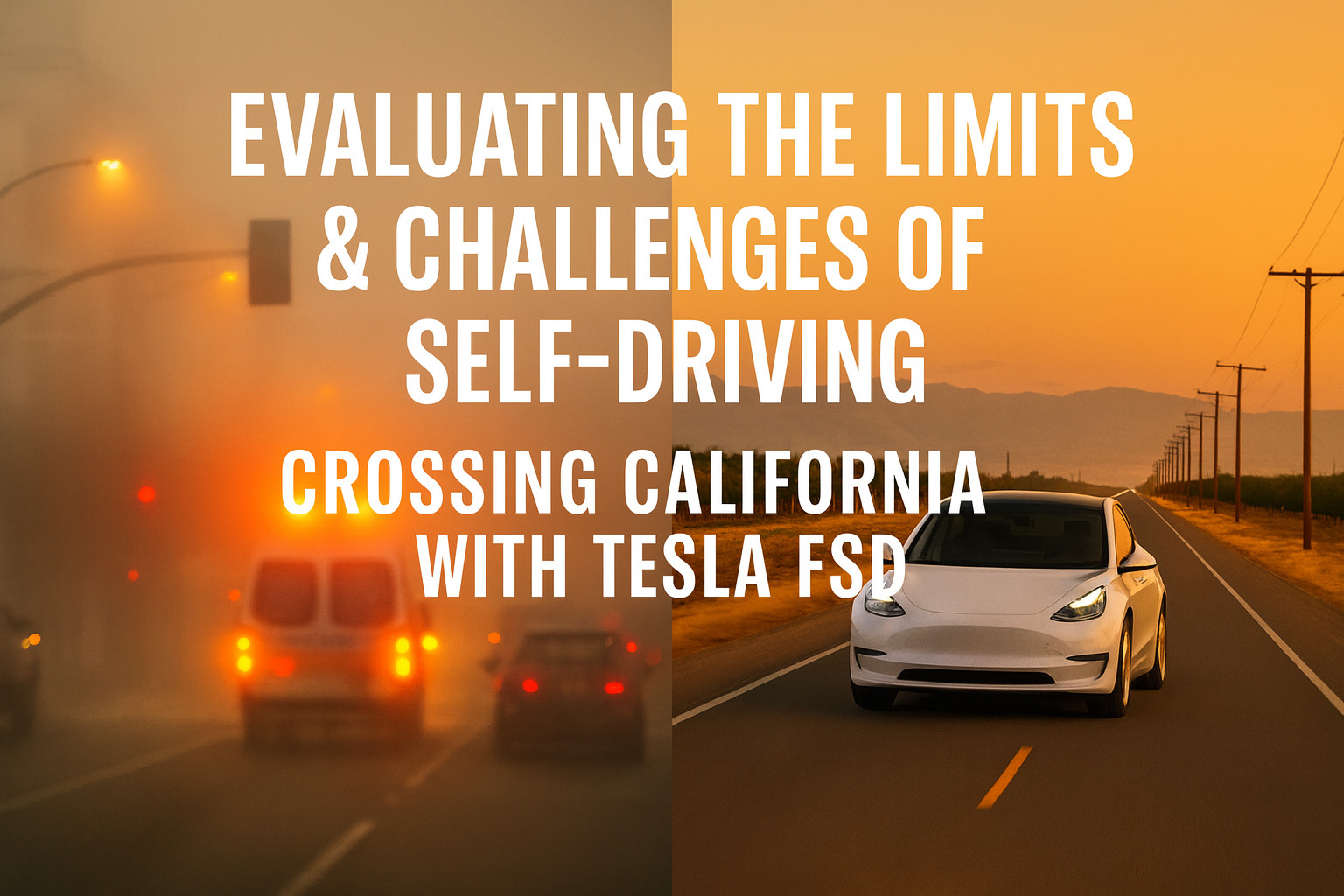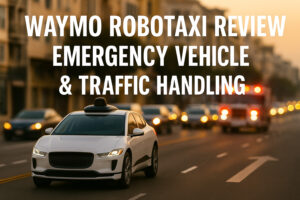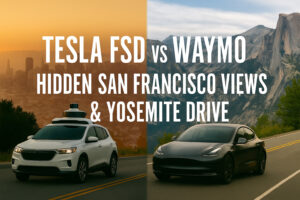Evaluating the Limits and Challenges of Self-Driving: Crossing California with Tesla FSD

Crossing California with Tesla FSD: San Francisco → Yosemite Part 4
Introduction
In Part 4 of our trip from San Francisco to Yosemite National Park, we confront the real-world performance and limitations of FSD.
After leaving the Turlock Supercharger, we drove to roughly the 130-mile mark and observed several noteworthy FSD behaviors.
This report offers an objective look at FSD’s boundaries and potential, not just under ideal conditions but in everyday road situations.
*This article condenses the key points from the video below into text form.*
If something sparks your curiosity, be sure to watch the full video!
🛣️ Route Overview – Part 4
- Starting point: Turlock Supercharger
- Distance covered: 101 miles → 130 miles (total)
- Distance remaining: about 70 miles (to Yosemite)
- FSD version: 12.5 or later
- Note: Observed and analyzed several FSD behavior issues
Tesla Supercharger: Autopark Feature
This leg of the journey let us try Tesla’s “Autopark.”
The car backs into a spot entirely on its own, while the screen shows every move in real time—so you can let it handle the job with complete confidence.
🔋 Typical Supercharger Times
- 0→80 %: about 20–30 minutes
- Full charge (100 %): roughly 40–50 minutes
- Recommended level: usually stop at 80 % to protect battery health
- Long trips: top up to 100 % when needed
Detailed Analysis of FSD Behavior: Investigating Multiple Incidents
During this leg we observed several noteworthy actions by FSD v12.5 and later.
While not necessarily “problems,” they offer valuable insight into the current limits of autonomous driving and where improvements are still needed.
Incident 1: Unstable Maneuvering Near a Large Truck
🚛 Situation Analysis: Unexpected Lane Change While Passing a Truck
Discussion
The real head-scratcher is why FSD tried to merge into the truck’s lane at all.
The next exit was still far away, so there was little practical need to move right. Possible causes include:
- The system deemed the approaching rear-left vehicle a higher risk
- A momentary FSD malfunction
- An unexpected speed change by the truck that confused the model
Incident 2: Decision-Making During a Lane Merge
🛣️ Situation Analysis: Complex Judgment in a Right-Lane Merge
Room for Improvement
Because FSD had already recognized the upcoming merge, an ideal response would have included:
- Shifting to the far-left lane well in advance
- Slowing to match the merging truck’s speed
- Committing to the lane change earlier in the process
Incident 3: Temporary Navigation Confusion
🗺️ Situation Analysis: Wrong Turn Toward an Unplanned Exit
Despite the route being set to continue straight on the freeway, FSD briefly attempted to head for a different exit.
The maneuver looked like the kind of “whoops” a human driver might make—showing that the system can still slip in a very human way.
⚠️ Key Takeaway: If you take the wrong exit, getting back onto the freeway can cost significant time.
In moments like this, quickly disengaging FSD and taking manual control is crucial.
FSD vs. LiDAR: Comparing Technical Approaches
Fundamental Differences in Sensor Technology
This journey underscored the contrast between Tesla’s camera-based strategy and Waymo’s LiDAR-centric methodology.
LiDAR (Waymo) Highlights
- How it works: Emits laser pulses and measures the return time to map distance and shape
- Accuracy: Millimeter-level distance readings
- Environmental resilience: Performs well in darkness, fog, or other low-visibility conditions
- Cost: Expensive sensors drive up vehicle price
Camera + AI (Tesla) Highlights
- Philosophy: Mimics how humans drive—eyes plus brain
- Cost: Relatively inexpensive and scalable for mass production
- Limitations: Performance can suffer in glare, fog, or heavy dust
- Learning curve: Continuously improves through vast data collection
NHTSA Investigation & Safety Challenges
🚨 Critical Safety Note: In 2024 the U.S. National Highway Traffic Safety Administration (NHTSA) opened an investigation covering roughly 2.4 million Teslas.
Several FSD-related crashes occurred in poor-visibility conditions—bright sun glare, fog, or dust—including one fatal incident.
The probe aims to assess whether FSD properly detects and handles low-visibility situations.
Like human drivers, a camera-only system faces inherent limits under bad weather or obscured vision, and this investigation highlights those constraints.
Silicon Valley Sightseeing Spots
Fremont: A Giant Park in the City of Tesla’s Factory
Between driving segments, we stopped at a massive park in Fremont, home to Tesla’s main factory.
Spanning roughly 396 hectares—about the size of 84 Tokyo Domes—this green space lets you spot California’s ubiquitous squirrels as well as wild turkeys and deer.
Winchester Mystery House: San Jose’s Enigmatic Mansion
The Winchester Mystery House is one of Silicon Valley’s most popular attractions.
After 38 years of nonstop renovations ordered by Sarah Winchester, the widow of the rifle magnate, the house now boasts 160+ rooms and a maze-like layout—offering a delightfully spooky, labyrinthine tour.
NASA Ames Research Center
Visible from the freeway, NASA’s Ames Research Center hosts a variety of aerospace projects.
Although public access is limited, you can browse the gift shop for space-themed souvenirs.
Practical Safety Tips When Using FSD
✅ Advantages of FSD
- Reduces fatigue on long drives
- Improves safety by covering blind spots
- Delivers steadier, more consistent driving decisions
- Provides 360-degree monitoring via multiple cameras
⚠️ Situations to Watch Out For
- Driving near large trucks
- Complex lane-merge zones
- Poor visibility (fog, intense sun glare)
- Scenarios requiring multiple rapid decisions
🛡️ Practical Safety Advice:
- Be ready to take over instantly: Always stay prepared to switch to manual if FSD misbehaves.
- Leverage exterior cameras: Use your phone to view external camera feeds and confirm what FSD is “seeing.”
- Exercise judgment: If your goal is a comfortable ride, disengage FSD without hesitation whenever you feel uneasy.
- Keep observing: Pay extra attention around big rigs and when FSD makes navigation decisions.
Where Tesla FSD Is Now—and Where It’s Headed
The 130 miles we covered offer a clear snapshot of autonomous driving’s present state.
Even on version 12.5, FSD is not perfect; certain conditions still call for human judgment.
That said, these challenges are not hard limits—they’re opportunities for continual refinement.
Because FSD evolves via over-the-air updates, many of the issues we observed may already be patched in newer releases.
⚠️ Reality check: FSD is a driver-assistance feature, not full autonomy.
The driver must always watch the road and be ready to take over instantly.
Recap: Balancing Technology and Reality
Part 4 of our journey from San Francisco to Yosemite showcased both the exciting promise and the realistic limits of Tesla FSD.
The challenges we met over the first 130 miles prove that autonomous driving is still a work in progress, yet they also highlight how quickly the tech is advancing.
What stood out most were FSD’s “human-like” errors.
Rather than making perfectly mechanical choices, the system occasionally slipped in ways a person might—evidence that its decision-making is edging closer to human thought patterns.
Next up is the final 70 miles and our approach to Yosemite National Park.
We’re eager to see how FSD performs in a more natural setting and what a self-driving experience inside a national park will feel like.
🚗 Try FSD Yourself: EcoDrive offers rental cars equipped with Tesla’s Full Self-Driving (FSD), so when you’re in California, be sure to give it a try!
Our Services
We offer comprehensive automotive solutions—buy, sell, rent, and repair in one place.
Car Sales
Browse our lineup of quality used cars with transparent pricing and up to a two-year warranty on select models.
View InventoryAuto Repair
Get expert service from our certified Toyota Master Mechanic. We primarily service Toyota vehicles.
Schedule ServiceTrade-in / Sell
We pay top dollar for your vehicle—especially hybrids. Count on fair, transparent appraisals.
Get EstimateCar Rentals
Choose between fuel-saving hybrid rentals and a Tesla with Full Self-Driving Capability—both at competitive rates.
Reserve Now





